Plasmon-assisted Förster resonance energy transfer at the single-molecule level in the moderate quenching regime
- Bohlen, J. Institute for Physical and Theoretical Chemistry – NanoBioScience and Braunschweig Integrated Centre of Systems Biology (BRICS) - and Laboratory for Emerging Nanometrology (LENA) - Braunschweig University of Technology - Braunschweig - Germany
- Cuartero-González, Á. Departamento de Física Teórica de la Materia Condensada and Condensed Matter Physics Center (IFIMAC) - Universidad Autónoma de Madrid - E-28049 Madrid - Spain
- Pibiri, E. Institute for Physical and Theoretical Chemistry – NanoBioScience and Braunschweig Integrated Centre of Systems Biology (BRICS) - and Laboratory for Emerging Nanometrology (LENA) - Braunschweig University of Technology - Braunschweig - Germany
- Ruhlandt, D. Third Institute of Physics – Biophysics - Georg-August-Universität Göttingen - Göttingen - Germany
- Fernández-Domínguez, A. I. Departamento de Física Teórica de la Materia Condensada and Condensed Matter Physics Center (IFIMAC) - Universidad Autónoma de Madrid - E-28049 Madrid - Spain
- Tinnefeld, P. Faculty of Chemistry and Pharmacy - NanoBioScience - Ludwig-Maximilians-Universität München - München - Germany
- Acuna, Guillermo P. Department of Physics, University of Fribourg, Switzerland - Institute for Physical and Theoretical Chemistry – NanoBioScience and Braunschweig Integrated Centre of Systems Biology (BRICS) - and Laboratory for Emerging Nanometrology (LENA) - Braunschweig University of Technology - Braunschweig - Germany
-
23.04.2019
Published in:
- Nanoscale. - 2019, vol. 11, no. 16, p. 7674–7681
English
Metallic nanoparticles were shown to affect Förster energy transfer between fluorophore pairs. However, to date, the net plasmonic effect on FRET is still under dispute, with experiments showing efficiency enhancement and reduction. This controversy is due to the challenges involved in the precise positioning of FRET pairs in the near field of a metallic nanostructure, as well as in the accurate characterization of the plasmonic impact on the FRET mechanism. Here, we use the DNA origami technique to place a FRET pair 10 nm away from the surface of gold nanoparticles with sizes ranging from 5 to 20 nm. In this configuration, the fluorophores experience only moderate plasmonic quenching. We use the acceptor bleaching approach to extract the FRET rate constant and efficiency on immobilized single FRET pairs based solely on the donor lifetime. This technique does not require a posteriori correction factors neither a priori knowledge of the acceptor quantum yield, and importantly, it is performed in a single spectral channel. Our results allow us to conclude that, despite the plasmon-assisted Purcell enhancement experienced by donor and acceptor partners, the gold nanoparticles in our samples have a negligible effect on the FRET rate, which in turns yields a reduction of the transfer efficiency.
- Faculty
- Faculté des sciences et de médecine
- Department
- Département de Physique
- Language
-
- English
- Classification
- Physics
- License
-
License undefined
- Identifiers
-
- RERO DOC 326783
- DOI 10.1039/C9NR01204D
- Persistent URL
- https://folia.unifr.ch/unifr/documents/307964
Other files
Statistics
Document views: 93
File downloads:
- pdf: 201
- Supplementary material: 157

